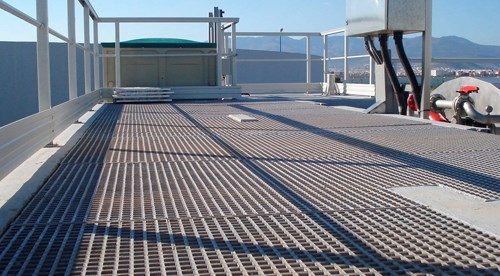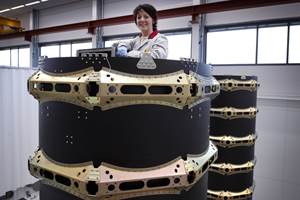ACMA publishes manual for FRP grating
ACMA issues standard for fiberglass grating with an eye for expanding the industrial composites market

The American Composites Manufacturers Association (ACMA, Arlington, VA, US) has published a new manual under the banner of the American National Standards Institute (ANSI, Washington, DC, US). “FRP Composites Grating Manual for Pultruded and Molded Grating and Stair Treads” is intended to educate engineers, designers and end-users about the properties, performance and uses of fiber-reinforced polymer (FRP) grating. Greater knowledge of the performance benefits of FRP will increase awareness of the material and enable engineers to design and use FRP with confidence, says ACMA. FRP grating is used in many industries, from walkways in industrial plants to flooring on ships to decorative grids on commercial and residential buildings. It is more durable and corrosion resistant than steel, which can rust and corrode in extreme environments.
Aldred D’Souza, P.E., the director of engineering/design at Fibergrate Composite Structures Inc. (Dallas, TX, US) and the chair of ACMA’s Fiberglass Grating Manufacturers Council, says, “The successful completion of the FRP Composites Grating Manual marks a major milestone in the advancement of the Industry. This new standard should increase the awareness of FRP grating and its suitability in a wide range of markets beyond wastewater treatment plants, waterparks and chemical plants. As FRP gratings become more mainstream because of this wider acceptance, market expansion for composites is evident.” Other members of the Fiberglass Grating Manufacturers Council who also participated in development of the publication include Strongwell (Bristol, VA, US), Delta Composites LLC (Spring, TX, US), Seasafe Inc. (Lafayette, LA, US), Creative Pultrusions Inc. (Alum Bank, PA, US), Owens Corning (Toledo, OH, US), Interplastic Corp. (St. Paul, MN, US), Precisioneering Ltd. (Scarborough, Ontario, Canada), and ChinaGrate (Nantong, Jiangsu Province, China).
The new publication is not a design manual nor requirement, but a voluntary consensus standard. Approval of an American National Standard requires review by ANSI and assurance that the requirements for due process, consensus and other criteria for approval have been met by the standards developer, in this case, ACMA. Consensus is established when, in the judgment of the ANSI Board of Standards Review, substantial agreement has been reached by “directly and materially affected interests.” The use of American National Standards is completely voluntary; their existence does not in any respect preclude anyone, whether he or she has approved the standard or not, from manufacturing, marketing, purchasing, or using products, processes, or procedures not conforming to the standards, emphasizes ACMA in the standard’s Preface.
The FRP Composites Grating Manual has three sections:
- Load Tables: A quick reference for engineers to compare the performance of FRP grating types under specified load conditions.
- Code of Standard Practice: Representation of generally accepted standard practices in the fiberglass grating industry
- Generic Specification: Suggested guidance for engineers and owners when purchasing composite grating, keeping all grating manufacturers on a level playing field. This specification also promotes manufacturing of gratings that will have minimum performance standards.
The new FRP Composites Grating Manual (print and digital versions) can be found at the ACMA Education Hub. The manual costs $50 for ACMA members and $75 for nonmembers for a hard copy. A digital download (PDF) version costs $40 for members and $60 for nonmembers.
To learn more about ACMA’s Fiberglass Grating Manufacturers Council, contact John Busel at jbusel@acmanet.org.
Related Content
Materials & Processes: Fibers for composites
The structural properties of composite materials are derived primarily from the fiber reinforcement. Fiber types, their manufacture, their uses and the end-market applications in which they find most use are described.
Read MoreMaterials & Processes: Composites fibers and resins
Compared to legacy materials like steel, aluminum, iron and titanium, composites are still coming of age, and only just now are being better understood by design and manufacturing engineers. However, composites’ physical properties — combined with unbeatable light weight — make them undeniably attractive.
Read MoreRUAG rebrands as Beyond Gravity, boosts CFRP satellite dispenser capacity
NEW smart factory in Linköping will double production and use sensors, data analytics for real-time quality control — CW talks with Holger Wentscher, Beyond Gravity’s head of launcher programs.
Read MoreThe state of recycled carbon fiber
As the need for carbon fiber rises, can recycling fill the gap?
Read MoreRead Next
CW’s 2024 Top Shops survey offers new approach to benchmarking
Respondents that complete the survey by April 30, 2024, have the chance to be recognized as an honoree.
Read MoreComposites end markets: Energy (2024)
Composites are used widely in oil/gas, wind and other renewable energy applications. Despite market challenges, growth potential and innovation for composites continue.
Read MoreFrom the CW Archives: The tale of the thermoplastic cryotank
In 2006, guest columnist Bob Hartunian related the story of his efforts two decades prior, while at McDonnell Douglas, to develop a thermoplastic composite crytank for hydrogen storage. He learned a lot of lessons.
Read More















.jpg;maxWidth=300;quality=90)










